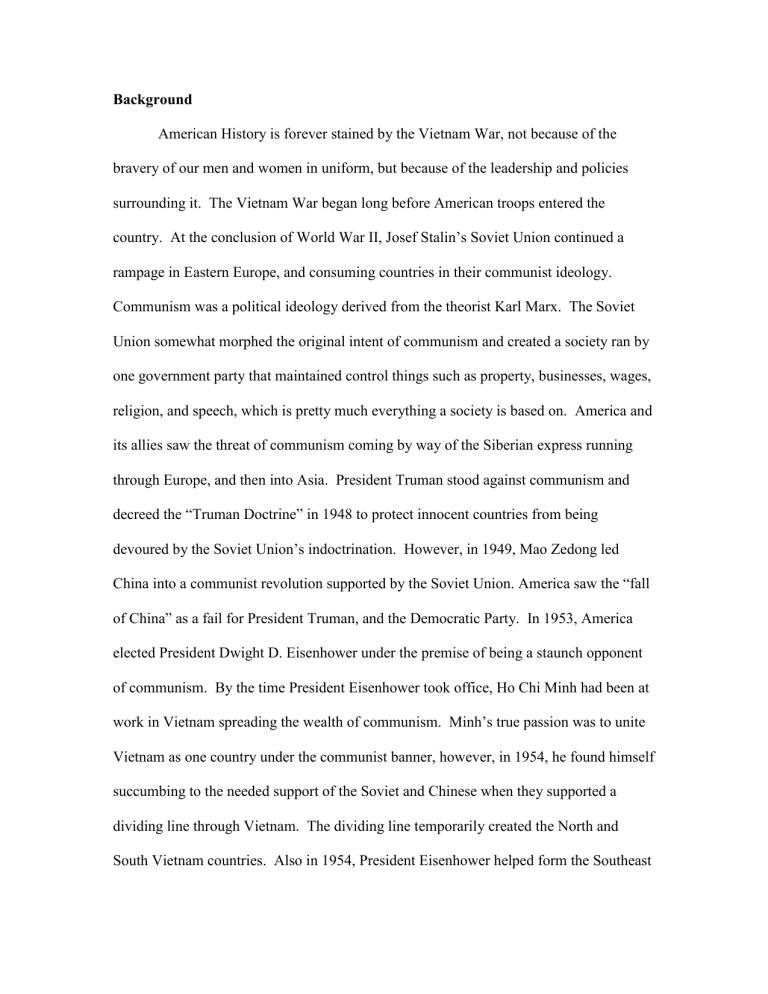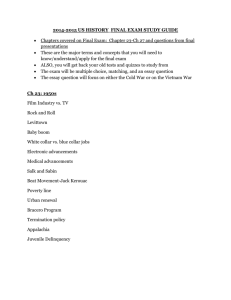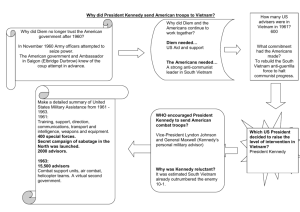
Background American History is forever stained by the Vietnam War, not because of the bravery of our men and women in uniform, but because of the leadership and policies surrounding it. The Vietnam War began long before American troops entered the country. At the conclusion of World War II, Josef Stalin’s Soviet Union continued a rampage in Eastern Europe, and consuming countries in their communist ideology. Communism was a political ideology derived from the theorist Karl Marx. The Soviet Union somewhat morphed the original intent of communism and created a society ran by one government party that maintained control things such as property, businesses, wages, religion, and speech, which is pretty much everything a society is based on. America and its allies saw the threat of communism coming by way of the Siberian express running through Europe, and then into Asia. President Truman stood against communism and decreed the “Truman Doctrine” in 1948 to protect innocent countries from being devoured by the Soviet Union’s indoctrination. However, in 1949, Mao Zedong led China into a communist revolution supported by the Soviet Union. America saw the “fall of China” as a fail for President Truman, and the Democratic Party. In 1953, America elected President Dwight D. Eisenhower under the premise of being a staunch opponent of communism. By the time President Eisenhower took office, Ho Chi Minh had been at work in Vietnam spreading the wealth of communism. Minh’s true passion was to unite Vietnam as one country under the communist banner, however, in 1954, he found himself succumbing to the needed support of the Soviet and Chinese when they supported a dividing line through Vietnam. The dividing line temporarily created the North and South Vietnam countries. Also in 1954, President Eisenhower helped form the Southeast Asia Treaty Organization (SEATO), which would allow America and its allies to become involved in conflicts in Southeast Asian countries, including South Vietnam, where communism had begun to take root. Since South Vietnam was technically a “new country,” that left the governance up for grabs. The selection of Ngo Dinh Diem as leader was the beginning of the end of South Vietnam’s fall to the North. Diem was exceptional on paper, and may have had some potential to be great leader because of his background. However, Diem’s preferential treatment of Catholics, and repression of the people made Ho Chi Minh look like a great leader. President Eisenhower tried to put out the trail of fire Diem’s regime was leaving behind, and bolstered it as the only hope of South Vietnam. “Because the Diem government had survived for over six years as a hallmark of American commitment to its own vision of a stable and peaceful Asia, however, the United States was trapped by the very success of the Eisenhower administration in keeping Diem in power and in promoting his symbolic role.”1 As the North continued attacks via guerilla warfare on the South, and established more supporters of their government, the aftermath was turned over to the next President, President John F. Kennedy. Introduction/Thesis The fact that America and allies did not quench Ngo Dinh Diem sooner left a furthering problem for Presidents John F. Kennedy, and Lyndon B. Johnson. As the problem in Vietnam grew, so did the need for American involvement. Presidents Kennedy and Johnson had two different strategies to the war in Vietnam. Although the 1 two strategies were different, neither of them were effective, and they led to a longstanding war, then humiliating retreat from Vietnam. Body President John F. Kennedy was elected as President of the United States in 1961 amid the growing tensions with Vietnam. President Kennedy was barely elected because of Richard Nixon’s known staunch opposition to communism. President Kennedy ran for the Democratic Party, which was still recovering from the “fall of china” under the last democrat, President Truman. Ngo Dinh Diem was still in power of South Vietnam and President Kennedy saw it fit to keep him there for the time being. Diem’s regime would ultimately fall under Kennedy’s presidency. While Kennedy was in office, Diem lost more and more support of his people, “Though 80 percent of the South Vietnamese population belonged to the Buddhist faith, Diem seemed to go out of his way to antagonize them.”2 As the uprisings in South Vietnam came against Diem, and support drew closer to Ho Chi Minh, President Kennedy thought the best option for U.S. intervention to be counter insurgency. “Kennedy maintained that in smaller wars against the communists the United States should rely on conventional (i.e., non-nuclear) and special forces, and especially on the latter in conflicts in which the enemy used guerrilla warfare and other irregular means.”3 The idea behind counter insurgency is defensive warfare. This strategy has its place, but without going on the offensive, it doesn’t push the enemy back, so they keep the foothold they already have. President Kennedy also only sent troops who he referred to as “advisors” to the South Vietnamese. The “advisors” were to teach the South Vietnamese these tactics without becoming directly 2 3 involved. With South Vietnamese support wavering under Diem, the North Vietnam sympathizers could’ve easily posed as South Vietnamese troops, and then reported the tactics back to the North. By sending aid to South Vietnam, President Kennedy maintained the appearance that he was active in the war on communism, but in reality, the support of Diem, and the tactics to fight allowed North Vietnam to gain stronger foothold in the South. The support Kennedy provided monetarily and with manpower, committed the United States past the point of backing out. “Viet Cong guerillas now control much of the countryside in South Vietnam and frequently ambush South Vietnamese troops. The cost to America of maintaining South Vietnam’s sagging 200,000 man army and maintaining the overall conflict in Vietnam rises to a million dollars per day.”4 Near the end of his presidency, Kennedy came to the realization that America was not being very effective in pushing back the North Korean insurgency. President Kennedy was ready to gradually pull American forces out of South Vietnam until he learned of a coup to overthrow Diem’s government. President Kennedy prematurely, and possibly out of frustration, pledged support to the new government before learning how it’s business was going to be conducted differently than Diem’s. Kennedy had committed U.S. intervention in South Vietnam by providing substantial assistance. William Rust, author of Kennedy in Vietnam, American Foreign Policy from 1960-1963, presents the idea that Kennedy’s policies made the government of South Vietnam reliant on United States intervention.5 In November of 1963, President Kennedy was tragically assassinated, which left the inheritance of the Vietnam War, and the obligation to protect South Vietnam, to his Vice President, Lyndon B. Johnson. 4 5 President Lyndon B. Johnson took office and relied on diplomacy to win over the Vietnamese. President Johnson was surrounded by people who were ready and willing to be proactive in the Vietnam War, but Johnson was too indecisive, and cautious. The indecisiveness of Johnson led him to take no action at all, even when presented with viable options. One plan Johnson was given would’ve taken out North Vietnam’s railroads, industries, barracks, and training camps. Then it would’ve “choked off” aid by sea by blocking several ports. However, “After Dean Rusk agreed with Rostow's idea, the State Department prepared the draft of an enabling resolution for the president to put before Congress. But Johnson still took no action. He was not convinced that the moment was right for such a resolution, and he put it aside for the time being.”6 (pg. 72) Johnson was still aware of public perception when it came to his action, or inaction, on the spread of communism. Johnson embellished parts, and withheld the truth, about two incidents that occurred in the Gulf of Tonkin in order to receive a “go ahead” from congress to retaliate against North Vietnam. It still took Johnson receiving word from General Westmoreland that South Vietnam was going to fall if he did not get any reinforcements. Johnson finally sent battle ready troops to gain control of South Vietnam. However, America and South Vietnam was well behind the curve by the time Johnson sent the troops to General Westmoreland. While President Johnson was dealing with the Vietnam War, he was waging another war on the home front. Johnson initiated the “Great Society” which provided billions of dollars of aid for Americans living below the poverty level. Among being one of the most expensive domestic policies since Franklin Roosevelt’s New Deal, it was one 6 of the worst ever to be implemented. “Johnson’s caution reflected his reluctance to do anything abroad that might distract domestic attention from Great Society reforms. He saw Vietnam as a potential trap that could frustrate his principle goals and politically injure him.”7 The mobilization of troops to Vietnam proved to cost much more than Johnson had predicted, so he ended up having to pull funds from domestic programs, including the Great Society. The funding pulled from domestic programs led to more and more public disapproval of the Vietnam War, which led to more protests. The Great Society was ill-timed and cost the United States billions of dollars that it needed during a foreign war. Conclusion The Vietnam War the longest war America had fought in until the more recent Iraq and Afghanistan Invasions. The Vietnam War was a humiliation for Americans because of the tip-toe and backdoor strategies by the two presidents who led us into the beginning of the war. President Kennedy realized that South Vietnam was overwhelmingly unsupportive of Ngo Dinh Diem as its leader. It’s hard to ask a country to follow a leader they strongly disagreed with. The United States’ continued support of Diem may have also affected South Vietnamese view of foreign intervention. All the more reason to support the North’s conquest to unite Vietnam. The transition between Kennedy and Johnson was the transition between tip-toes to backdoor. Johnson lied several times in order to gain approval from congress, and the public. Even when Johnson mobilized troops, he left out details as to which troops, and how they would be deployed. “But what Johnson did not tell his viewers was as important as what he did tell 7 them. He did not tell them that he had rejected the JCS's advice to carry out a general mobilization of the civilian reserves and the National Guard in order to augment the strength of the regular forces.”8 (pg. 87) The Vietnam War may not have been as long and inconclusive for the United States had it been handled better in the beginning stages, during the Kennedy and Johnson administrations. Bibliography 4- http://www.historyplace.com/unitedstates/vietnam/index-1961.html 1- Trapped by Success: The Eisenhower Administration and Vietnam, 1953-61; book by David L. Anderson 5- Kennedy in Vietnam, American Foreign Policy from 1960-1963 pg. 51; book by William J. Rust 7- Flawed Giant: Lyndon Johnson and His Times, 1961-1973 pg. 242; book by Robert Dallek https://books.google.com/books?id=G_J3PEegwdYC&pg=PA242&lpg=PA242&dq=#v= onepage&q&f=false 2,3,6- America’s war in Vietnam: A Short Narrative History; book by Larry Addington 8




